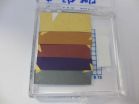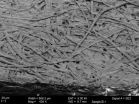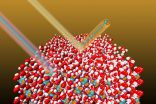(Press-News.org) WASHINGTON D.C., September 30, 2014 – Applying a well-known optical phenomenon called thin-film interference, a group of researchers at Harvard University has demonstrated the ability to "paint" ultra-thin coatings onto a rough surface -- work that holds promise for making future, flexible electronic devices, creating advanced solar cells and detailing the sides of next-gen rocket ships and spacecraft with extremely lightweight decorative logos.
When light passes through oil in water, it becomes iridescent, revealing a myriad of colors that glisten and shift along with your perspective. This behavior, known as thin-film interference, is well-studied and is implemented in creating all manner of optical devices. Recently, the Harvard team demonstrated that this behavior can persist when patterned on extremely rough and flexible surfaces.
"Normally when you think of thin-film interference, you think of smooth substrates," said Mikhail Kats, a postdoctoral fellow at Harvard University working in the lab of Federico Capasso. He and Capasso describe their work in the journal Applied Physics Letters, from AIP Publishing. "With increasing roughness the effect is expected to fade and you just don't get this coherent behavior."
Optically speaking, notebook paper is at the far end of the roughness spectrum, owing to its fibrous composition. However, after the researchers deposited onto paper an initial layer of gold and a subsequent layer of germanium, the paper began to display interference. The optical trickery lies in the influence of the film's angle of incidence.
Traditionally, thin films needed to be transparent and no thinner than roughly one-quarter of the wavelength of light – 600 nm – to exhibit interference colors. This is due to the phase shifts, or changes in optical path length, which occur as a result of changes in the observer's angle of incidence. The path length directly corresponds to which colors appear to an observer - tilt your head and they change slightly. At the nanometer scale, however, the amount of phase shift that occurs is greatly diminished due to the significantly smaller thickness of the films, resulting in a decrease in the angle of incidence's effect. Tilt your head now, and the colors remain unchanged.
"You can use this effect to essentially see atomic monolayers, bilayers or tri-layers with your naked eye," Kats said.
This would allow for the coloring of metallic objects by use of far less material than with traditional paint – a claim confirmed by the orange, indigo, and violet hues visible from the 7, 10 and 15 nm layered sheets of paper.
"There's a famous story where, by not painting the space shuttle's fuel tank, 600 pounds were saved, because that's how much the paint weighed," Kats said. "If you wanted to put a logo on something that you're sending up in space, or you wanted to color it, here you could do it without almost any increase in weight."
Future applications of the films include making extremely thin, flexible photodetectors and optoelectronic devices, including solar cells.
"I don't think a solar cell made out of these materials is going to break any efficiency records, but we might demonstrate one that uses 1/10th-1/100th of the material of a conventional cell," Kats said. "And that's still an interesting parameter to explore when it comes to cost."
INFORMATION:
The article, "Ultra-thin optical interference coatings on rough and flexible substrates" is authored by Mikhail A. Kats and Federico Capasso. It will appear in the journal Applied Physics Letters on September 30, 2014. After that date, it can be accessed at:
http://scitation.aip.org/content/aip/journal/apl/105/13/10.1063/1.4896527
ABOUT THE JOURNAL
Applied Physics Letters features concise, rapid reports on significant new findings in applied physics. The journal covers new experimental and theoretical research on applications of physics phenomena related to all branches of science, engineering, and modern technology. See: http://apl.aip.org
Taking thin films to the extreme
Layering rough surfaces with nanometer-thin optical interference coatings opens new array of possible applications, such as nearly weight-free logos on the sides of spacecraft
2014-09-30
ELSE PRESS RELEASES FROM THIS DATE:
Unexpected new mechanism reveals how molecules become trapped in ice
2014-09-30
WASHINGTON D.C., Sept. 30, 2014 – Ice is ubiquitous in nature—found within terrestrial and astrophysical environments alike—and contains many atoms and molecules trapped inside it. For example, ice beneath the world's oceans hosts a vast reservoir of greenhouse gases, which if released would have a profound effect on climate change.
On the earth's surface, seasonal ice and permafrost-covered regions represent a vast reservoir for the collection, concentration and release of environmental and trace gases—encompassing national security concerns about the persistence and ...
Breakthrough study discovers 6 changing faces of 'global killer' bacteria
2014-09-30
Every ten seconds a human being dies from pneumococcus infection making it the leading cause of serious illness across the globe
Research discovers six unique states of pneumococcus
Knowledge of these six characteristics can help in development of tailored vaccines
Every ten seconds a human being dies from Streptococcus pneumoniae infection, also known as pneumococcus, making it a leading global killer.
An interdisciplinary team of researchers from the University of Leicester in collaboration with international experts have unlocked a genetic switch controlling ...
Americans undergo colonoscopies too often, study finds
2014-09-30
Colonoscopies are a very valuable procedure by which to screen for the presence of colorectal cancer. However, it seems that healthy Americans who do undergo this sometimes uncomfortable examination often have repeat screenings long before they actually should. Gina Kruse of Massachusetts General Hospital in the US and colleagues advise that endoscopists stick to the national guidelines more closely. Their findings appear in the Journal of General Internal Medicine, published by Springer.
Current national guidelines strongly recommend that adults aged 50 and older should ...
Longitudinal report shows challenging reality of ageing with an intellectual disability
2014-09-30
Dublin, Ireland, September 30th, 2014 – A new report launched today by the Intellectual Disability Supplement to TILDA (The Irish Longitudinal Study on Ageing) conducted by academics from the School of Nursing and Midwifery, Trinity College Dublin, Ireland, has highlighted the serious, complex and unique health and social challenges facing Ireland's intellectual disability population.
The IDS-TILDA study is the first study of its kind in Europe and the only one in the world with the ability to compare the ageing of people with intellectual disability directly with the ...
Contaminated water linked to pregnancy complications, BU study finds
2014-09-30
Prenatal exposure to tetrachloroethylene (PCE) in drinking water may increase the risk of stillbirth and placental abruption, according to a new study led by a Boston University School of Public Health researcher.
The study, published in the journal Environmental Health, compared 1,091 PCE-exposed pregnancies and 1,019 unexposed pregnancies among 1,766 women in Cape Cod, Ma., where water was contaminated in the late 1960s to the early 1980s by the installation of vinyl-lined asbestos cement pipes. PCE exposure was estimated using water-distribution system modeling software. ...
NEJM: Crizotinib effective in Phase 1 trial against ROS1 lung cancer
2014-09-30
The New England Journal of Medicine reports positive results of a phase 1 clinical trial of the drug crizotinib against the subset of lung cancer marked by rearrangement of the gene ROS1. In this multi-center study of 50 patients with advanced non-small cell lung cancer testing positive for ROS1 gene rearrangement, the response rate was 72 percent, with 3 complete responses and 33 partial responses. Median progression-free survival – the time it takes for the disease to resume its growth after being slowed by treatment – is estimated at 19.2 months with exactly half of ...
Pollution linked to lethal sea turtle tumors
2014-09-30
DURHAM, N.C. -- Pollution in urban and farm runoff in Hawaii is causing tumors in endangered sea turtles, a new study finds.
The study, published Tuesday in the peer-reviewed open-access journal PeerJ, shows that nitrogen in the runoff ends up in algae that the turtles eat, promoting the formation of tumors on the animals' eyes, flippers and internal organs.
Scientists at Duke University, the University of Hawaii and the National Oceanic and Atmospheric Administration (NOAA) conducted the study to better understand the causes behind the tumor-forming disease Fibropapillomatosis, ...
Adolescent exposure to thc may cause immune systems to go up in smoke
2014-09-30
When it comes to using marijuana, new research, involving mice and published in the October 2014 issue of the Journal of Leukocyte Biology, suggests that just because you can do it, doesn't mean that you should. That's because a team of Italian scientists have found that using marijuana in adolescence may do serious long-term damage to the immune system. This damage may result in autoimmune diseases and chronic inflammatory diseases, such as multiple sclerosis, inflammatory bowel disease and rheumatoid arthritis in adulthood.
"I hope that the knowledge that early exposure ...
Cancer therapy: Driving cancer cells to suicide
2014-09-30
Researchers of Ludwig-Maximilians-Universitaet (LMU) in Munich report that a new class of chemical compounds makes cancer cells more sensitive to chemotherapeutic drugs. They have also pinpointed the relevant target enzyme, thus identifying a new target for anti-tumor agents.
Researchers led by LMU's Professor Angelika Vollmar and Professor Stephan Sieber of the Technische Universität München have identified a class of chemicals that represent a potential new weapon in the fight against malignant tumors. The compound is itself non-toxic, but it stimulates the killing ...
Scientists identify which genes are active in muscles of men and women
2014-09-30
If you want your doctor to know what goes wrong with your muscles because of age, disease or injury, it's a good idea to know what "normal" actually is. That's where a new research report published in the October 2014 issue of the FASEB Journal comes in. In the report, a team of scientists produce a complete transcriptome—a key set of molecules that can help scientists "see" which genes are active in an organ at a particular time. What's more, they found never-before-detected gene activity and that men have approximately 400 more active genes in their skeletal muscle than ...
LAST 30 PRESS RELEASES:
Toxic chemicals from microplastics can be absorbed through skin
New research defines specific genomic changes associated with the transmissibility of the monkeypox virus
Registration of biological pest control products exceeds that of agrochemicals in Brazil
How reflecting on gratitude received from family can make you a better leader
Wearable technology assesses surgeons’ posture during surgery
AATS and CRF® partner on New York Valves: The structural heart summit
Postpartum breast cancer and survival in women with germline BRCA pathogenic variants
Self-administered acupressure for probable knee osteoarthritis in middle-aged and older adults
2024 Communicator Award goes to “Cyber and the City” research team based in Tübingen
A new therapeutic target for traumatic brain injury
Cosmic rays streamed through Earth’s atmosphere 41,000 years ago
ACP issues clinical recommendations for newer diabetes treatments
New insights into the connections between alcohol consumption and aggressive liver cancer
Unraveling water mysteries beyond Earth
Signs of multiple sclerosis show up in blood years before symptoms
Ghost particle on the scales
Light show in living cells
Climate change will increase value of residential rooftop solar panels across US, study shows
Could the liver hold the key to better cancer treatments?
Warming of Antarctic deep-sea waters contribute to sea level rise in North Atlantic, study finds
Study opens new avenue for immunotherapy drug development
Baby sharks prefer being closer to shore, show scientists
UBC research helps migrating salmon survive mortality hot-spot
Technical Trials for Easing the (Cosmological) Tension
Mapping plant functional diversity from space: HKU ecologists revolutionize ecosystem monitoring with novel field-satellite integration
Lightweight and flexible yet strong? Versatile fibers with dramatically improved energy storage capacity
3 ways to improve diabetes care through telehealth
A flexible and efficient DC power converter for sustainable-energy microgrids
Key protein regulates immune response to viruses in mammal cells
Development of organic semiconductors featuring ultrafast electrons
[Press-News.org] Taking thin films to the extremeLayering rough surfaces with nanometer-thin optical interference coatings opens new array of possible applications, such as nearly weight-free logos on the sides of spacecraft



